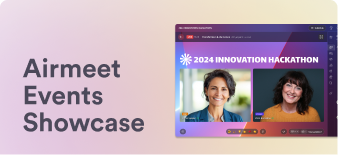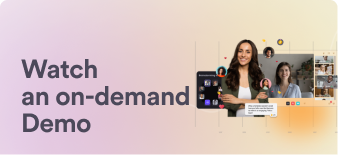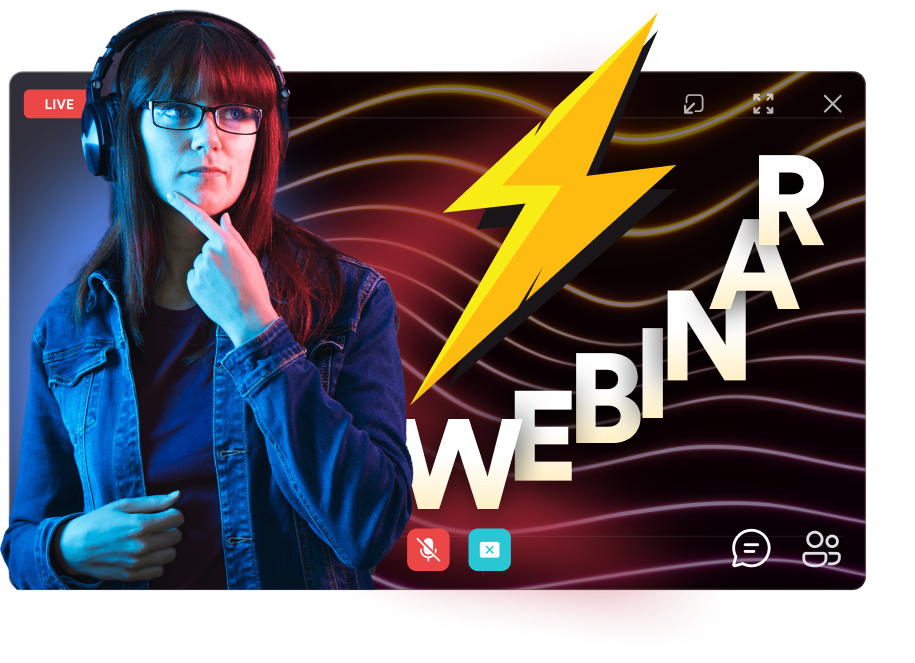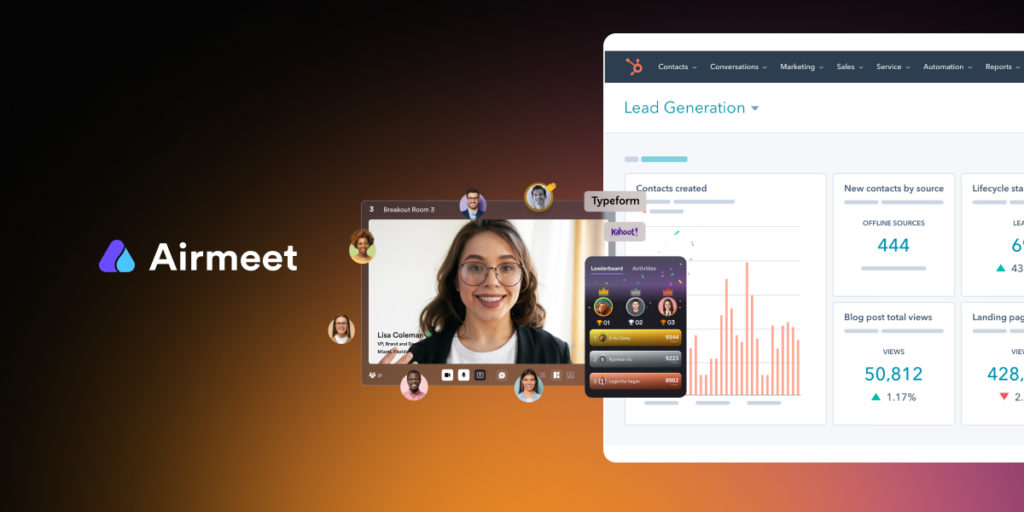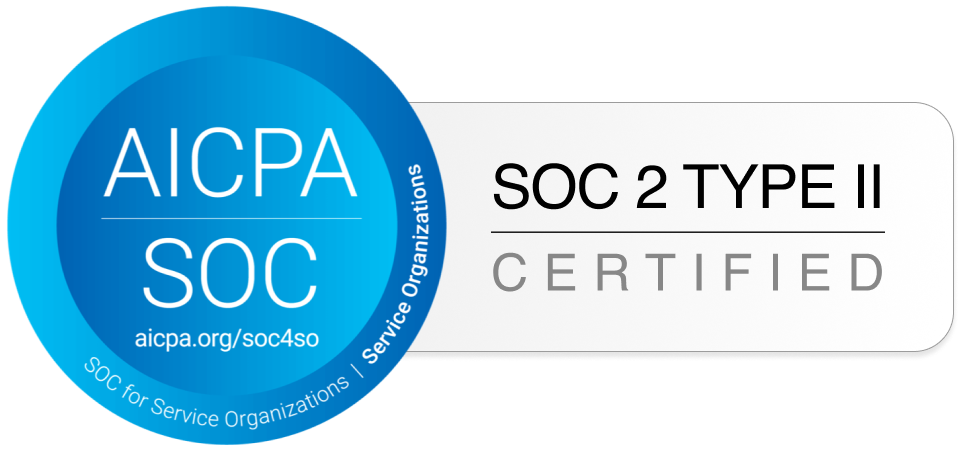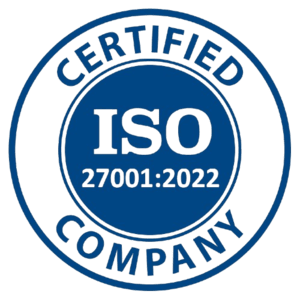This is where your webinar platform comes to your rescue, acting as a dependable assistant by supporting you at every stage of the webinar, through diverse & seamless API integrations.
In today’s fast-paced world, a webinar platform with powerful integrations is a necessity. Hosting a webinar goes beyond preparing content and securing speakers. At the end of the day, it’s about ensuring everything is in place, end-to-end.
- Have I sent out the invitations?
- How do I transfer event data to my company’s tech stack?
- Have I shared the upcoming webinar on social media?
- Is my live streaming platform set up properly and ready for use?
- Is the webinar landing page designed and ready to publish?
- How do I enable multilingual content?
All of these, and so many more such details that need to be taken care of, when hosting a webinar.
This is where webinar platform integrations come in handy. If you’re wondering how or why, here’s what we mean…?
Integrations empower you to efficiently handle almost every aspect of your webinar, from data collection to data transfer and live streaming.
But that’s not all!
They’re capable of bringing you a wealth of opportunities, empowering you in more ways than you’d imagine.
In this blog, we’ll discuss five key integrations your webinar platform must support, and other valuable integrations that can help host events seamlessly and unlock the full potential of your webinars.
Before we dive into the must-have webinar platform integrations, let’s first take a closer look at what API integrations are.
What are API Integrations
In simple terms, API integration connects two or more systems or applications to exchange data, perform specific actions, and automate workflows.
For webinar platforms, API integrations enable seamless data transfer between the platform and other essential tools, like CRM, marketing automation, social media, registration, and more.
This connectivity ensures efficient workflow & data flow and improves attendee management & engagement. It streamlines the entire webinar journey and provides an effortless user experience.
Top 5 Integrations Your Webinar Platform Must Support
Integrations are essential to ensure smooth webinar planning & hosting. They play an important role in seamless webinar execution and maintain a dynamic event experience for your attendees.
The right integrations will not only help you streamline workflows, but also enhance attendee engagement and gather valuable insights for optimizing your event strategy.
In this section, we will explore the top 5 integrations every webinar platform should support to ensure an efficient journey and engaging webinar.
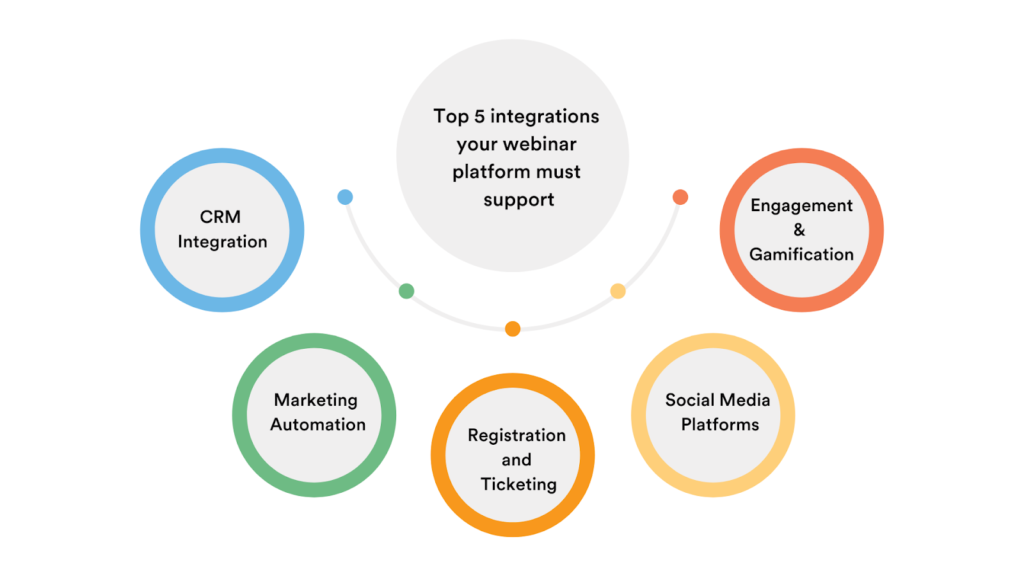
1. Customer Relationship Management (CRM) Integration
Integrating your CRM solution with your webinar platform allows you to collect, organize, and manage participant’s data efficiently. With a strong CRM system in place, you can also track leads and personalize interactions based on attendee behavior & engagement levels.
Leveraging these CRM tools helps you centralize all attendee information, making it easier for sales & marketing teams to:
- Effortlessly track and manage leads, by syncing webinar registrants and attendee details directly into your tech stack.
- Refine your approach based on real-time, data-driven webinar insights, like poll responses, chat participation, and emoji reactions.
- Craft tailored follow-ups to suit attendee interests and registrant requirements.
Examples CRM tools for integration: Salesforce, HubSpot, and Zoho CRM. |
2. Marketing Automation Integration
As the name suggests, marketing automation integration “automates” your webinar’s marketing, promotion, & nurture campaigns. Having this integration allows you to efficiently communicate before, during, and after the webinar across all stages. With an integrated marketing automation, you can:
- Automate promotional sequences, invitations, reminders, and post-webinar follow-ups.
- Simplify your lead generation, prospect nurturing, engagement, and conversion process.
- Assess the target audience’s response and level of interest to your email marketing campaigns.
- Track attendee interactions to score leads and effectively qualify leads.
- Segment your leads to deliver personalized content based on audience preferences.
Examples Some largely preferred marketing automation are Marketo and Pardot By Salesforce |
Read: Event Marketing Automation: The 2025 Guide
3. Registration and Ticketing Platform Integration
Registration and ticketing platforms are essential for a smooth webinar sign-up and check-in process. Leveraging these platforms ensures a straightforward webinar experience from the beginning. A well-integrated registration and ticketing system helps:
- Reduce friction for attendees by streamlining the initial registration process.
- Automate payment collection for paid webinars, via secure gateways.
- Sync attendee data in real-time to track sign-ups, traffic segmentation, and landing page CTRs (click-through rates).
- Gain access to a detailed registration report, directly on your webinar dashboard.
Examples Registration & ticketing platforms for Integration: Eventbrite and Zapier Payment gateways: Stripe and PayPal |
4. Social Media Integration
Social media plays a significant role in expanding your event’s reach and improving your brand’s visibility among your target audience. Integrating your webinar platform with social media enables you to:
- Add your company’s and event partners/sponsors (if applicable) social profiles
- Stream webinars and share events to diverse social channels directly from the webinar platform
Examples Popular social media platform integrations: Facebook, LinkedIn, Instagram, WhatsApp, YouTube, and X (formerly Twitter). |
5. Event Engagement and Gamification Integration
Event engagement and gamification integration are critical aspects of a webinar and contribute greatly to its success.
By optimizing on event engagement integration, you can increase attendee participation, improve learning experience, boost interactivity, facilitate networking with games, and increase attendee retention.
Integrating external engagement tools into the webinar platform enables you to:
- Host live quizzes and personalized polls
- Incorporate virtual avatars and 3D setups
- Plan creative sessions and spaces
- Create leaderboards and record scores
- Award badges and rewards, based on engagement levels & leaderboard positions.
Examples Some event engagement & gamification integrations are: Kahoot, Quizbreaker, and Skribble.io for quizzes and pictionary games Virbela for creating 3D remote setups & avatars Credly and Badgr for virtual badges |
Additional Valuable Webinar Platform Integrations
Analytics and Reporting
Integrating advanced analytics and detailed reporting tools into a webinar platform provides in-depth insights into overall webinar performance. From registrations & attendance to attendee behavior & engagement levels to drop-offs, you can track everything. You can leverage this data to:
- Make real-time adjustments to your webinar and drive better engagement
- Measure event ROI and success rate
- Identify hot leads, based on engagement & interaction levels
- Refine content strategies, based on audience response
- Improve future webinar strategies, based on comprehensive data points & analytics.
Feedback and Survey
Feedback and survey integrations enable you to collect real-time audience opinions about the content, speaker, and overall webinar experience. These valuable insights help businesses identify the areas of improvement, measure attendee satisfaction, and customize follow-ups and future sessions to suit their preferences.
Multilingual Transcriptions & Translations
Multilingual transcriptions & translations are essential, especially when you are targeting international or non-native audiences. These integrations enhance a webinar’s accessibility and global reach, by offering:
- Language translation options for registration and webinar landing page
- Multilingual real-time transcriptions or subtitles for live presentations
Google Sheets
Google Sheets integration with the webinar platform helps simplify data management. It allows webinar organizers to automatically export attendee insights and webinar data. It facilitates better record-keeping, easy sharing across teams, and support for data analysis without manual data entry.
Why Airmeet is Your Ideal Webinar Platform
Airmeet is a modern, fully integrated webinar platform that is equipped with diverse features and advanced functionalities. Airmeet provides webinar organizers and event planners with the flexibility to integrate their tech stack seamlessly and efficiently.
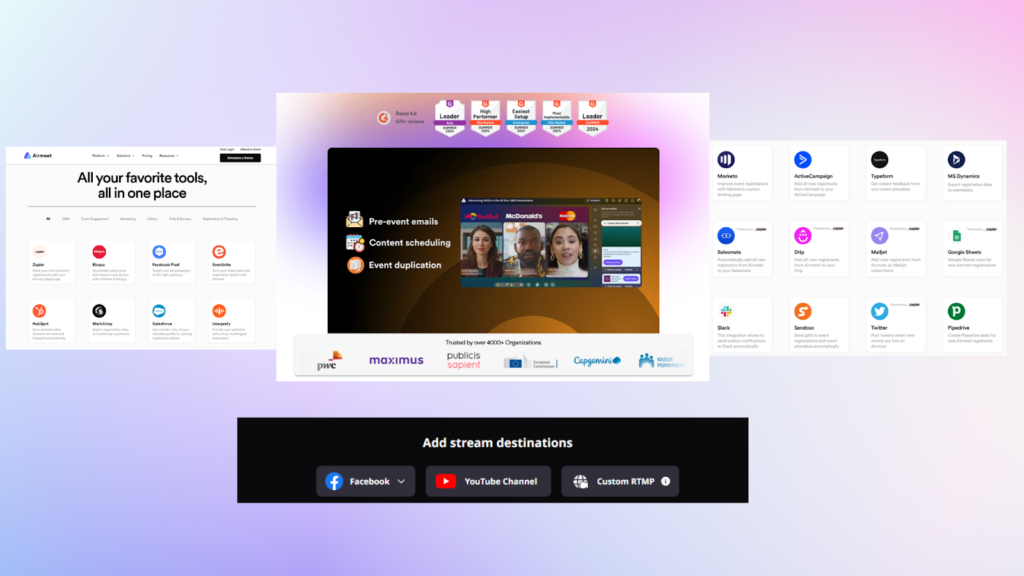
As an Airmeet user, you can integrate with 40+ tools, such as:
- CRM & Marketing: HubSpot, Salesforce, Salesmate, Sharpspring, Pardot, Marketo, Customer.io, SendInBlue, Facebook Pixel, and more.
- Event Engagement: Kahoot, DonorBox, Credly, etc.
- Polls & Survey: Typeform and SurveyMonkey.
- Registration & Ticketing: Eventbrite, Stripe, PayPal, Instapage, etc.
- Social Media: LinkedIn, Twitter, Facebook, and YouTube.
Airmeet’s webinar platform also offers the feasibility of streaming your event to a third-party platform, “Custom RTMP.” Additionally, you can request integrations & APIs suited to your webinar requirements.
Contact us to explore more or sign up for a free trial.
FAQs
Integrations provide several advantages to webinar organizers, such as:
- Eliminates the need for manual work, by automating repetitive tasks
- Improves efficiency of marketing campaigns
- Enhances quality of content with data-driven insights
- Helps expand audience reach, boost attendance, & amplify engagement
- Enables live streaming across social media platforms
Yes, AI integrations are now widely adopted in webinar and virtual event platforms. These integrations offer features like AI content generation & recommendation, chatbot assistance, analytics, and automated transcriptions.
In addition to the key integrations mentioned above, a webinar platform can also support collaboration tools like Slack, and gifts & certificates-generating tools like Sendoso and Accredible Certificates

